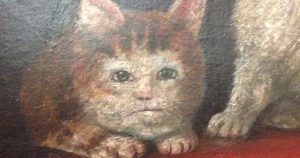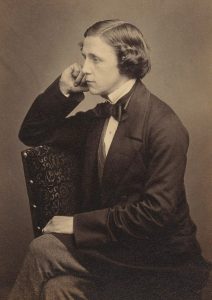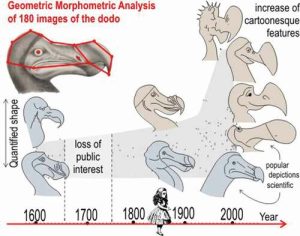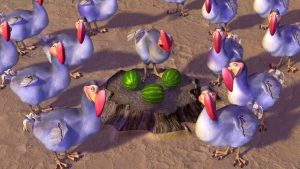When it comes to iconic animals of extinction, there are none better known (or as frequently name-dropped) than the Dodo. An animal so synonymous with the idea of being extinct that it even became a saying, “As dead as a Dodo.” But if you speak to most people and ask what they know about the Dodo, that’s pretty much where the knowledge starts and ends. However, there is a real species behind the legend and it holds more than a few surprises.
The scientific name of the Dodo is Raphus cucullatus. It’s a name that, on reading, makes you certain that the species would not have achieved quite as much fame if it didn’t have that catchy nickname as well. The reason for the name Dodo comes from the Pokémon school of naming organisms; the name we gave it is the name it gave itself. When first described by the sailors who discovered the birds, they talked about the low cooing noise they produced; a distinctive “Do-Do”.
Therefore, the name alone gives us a small clue about at least one aspect of the behaviour of the animal. Such tidbits are handy when there are no living examples for us to hear today. Sadly however, the only other regular nugget of information we gleaned from the sailors of yore was that the bird tasted like chicken. And thus the reason for their extinction is immediately apparent.
A lot of the behaviour of the animal may be a mystery, but, seeing as the Dodo only went extinct in the 17th century, a time when humans were already several centuries deep in our obsessive documenting of the world around us, you would have thought that we’d have a pretty good idea of what the animal looked like at least. A round, squat ball of fluffy feathers with a large beak and rather simple looking face. It’s a familiar image that everyone has seen at some point. It’s also dead wrong.

The Dodo is part of the pigeon family, having first evolved from ancestors not too dissimilar to the pigeons we know which arrived on the island of Mauritius fairly shortly after it first formed (approximately 8 million years ago). Over millennia, as has happened time and time again in the history of birds discovering islands, their descendants lost the ability of flight, taking advantage of the empty niche usually occupied by mammals.
Sadly, as the concept of extinction was pretty much unheard of in the 1600s, nobody really thought to keep much Dodo material for study. However, we do have a few skeletons, skin samples, and even, famously, a semi-mummified head in the Oxford Museum of Natural History. Enough certainly to study the animal and compare results to the well-known paintings (which, while more contemporary to the birds being alive, were done by people who had seen exactly the same number of live Dodos as us – none).

Time and time again, studies have shown that the bird was much leaner and more upright than most depictions show. The ribcage was slimmer, and the legs more muscular than stumpy. In fact, the evidence suggests that, if it wanted to be, a Dodo could be quite nippy, scurrying around the forest floor; far from the oft-seen waddle. Not that this should be surprising seeing as we do have reports from sailors of the time saying Dodos were speedy and often hard to catch; an account apparently missed by those historical painters.
As for the behaviour of the Dodo, CT scans of the skull have shown that it wasn’t dumb. Though it should be said, it wasn’t particularly smart either. Odds are the Dodo was probably a bird of perfectly average intelligence, and there’s no shame in that. This comes of course with the caveat that measuring the brain size of extinct animals isn’t an exact proxy for intelligence, but it can at least give grounds for a good estimate.
One thing that can be said with more certainty about the Dodo’s brain is that it appeared to have a fairly enlarged olfactory bulb. That is to say it probably relied heavily on its sense of smell to locate food; a feature common in forest floor dwellers who may have to rummage through the leaf-litter, the bird equivalent of a truffle pig.
So, if the real animal was so different, how did it get stuck with such an image problem? The answer, as it almost never is in palaeontology, is Lewis Carroll.

A recent study led by Alexandra van der Geer studied how the depictions of Dodos have changed over history using scientific techniques usually reserved for mapping the morphology of different species in an ecosystem. Here the technique was turned on one species alone, and not on the remains themselves, but instead on the historical records of drawings and animated representations of our poor Dodo.
What they found was a relatively reserved spread at first, followed by a sudden exponential growth in morphological diversity in the 20th century. They attributed this to the Dodo in Lewis Carroll’s ‘Alice in Wonderland’ bringing the bird back into the cultural zeitgeist following a period of relative disinterest. As a sad example of the negligence once shown to the world around us, the evidence suggested that in the years following the extinction of the bird people simply stopped caring about it. Once it was gone it was, for a while at least, totally forgotten.

Back in the public eye, the Dodo was open to a myriad of interpretations with plenty of artistic licence. One thing about using animals in cartoons is that, for them to be truly expressive, it requires an exaggeration of their facial features. For living animals this has no impact on public perception of the real thing, because, well, they can see them. Go to a zoo once and you’ll recognise that maybe 1994’s ‘The Lion King’ isn’t a scientifically accurate documentary.
But for the dodo, there was no such comparison readily available to be made. And so, the only point of reference in existence was that cartoonish fluffball in films, TV, and comic strips. The seed of the image was planted and thus it grew.
In the world of wildlife, the Dodo has certainly suffered more than most with a PR problem. Perhaps depicting this animal as clumsy, dim-witted, and destined for failure is a way of alleviating our own collective guilt for the human actions which caused its extinction. Claiming it was doomed from the start, a mistake of nature; truly, eating them all within a century of first discovering them was the right thing to do, a kindness.

Regardless of the manner in which it is remembered, it could be claimed that it is a good thing that this species is remembered at all. Arguably the Dodo is only present in common knowledge because it is dead, a level of fame far greater than it could possibly have achieved in life (unless of course it was a selfie darling for Instagram – looking at you Quokka). And thankfully slowly but surely the knowledge of the Dodo’s true look is also spreading. Though it has to be said, the Dodos themselves would likely find this a pretty slim silver lining against the heavy black cloud of all of them being dead.

Rhys Charles is the Engagement Officer for the Earth Sciences department of the University of Bristol, and has headed the Bristol Dinosaur Project since 2016. (@tweetodontosaur)
Article edited by Sophie Pollard
References
Claessens, L., Meijer, H., & Hume, J.P. (2016) The morphology of the Thirioux dodos. Journal of Vertebrate Palaeontology. 35, 29-187
Van der Geer, A.A.E., et al. (2021) The changing face of the dodo (Aves: Columbidae: Raphus cucullatus): iconography of the Walghvogel of Mauritius. Historical Biology. 34, 648-657

